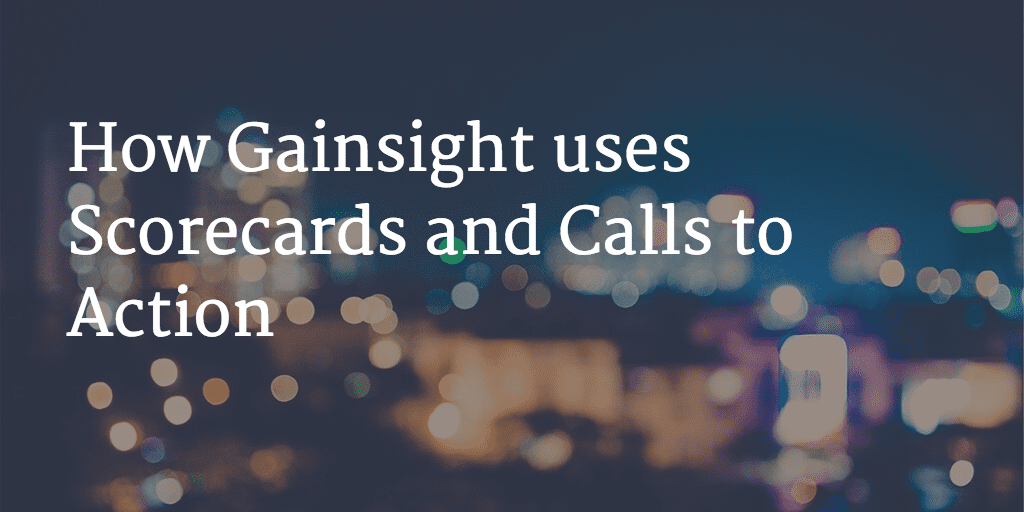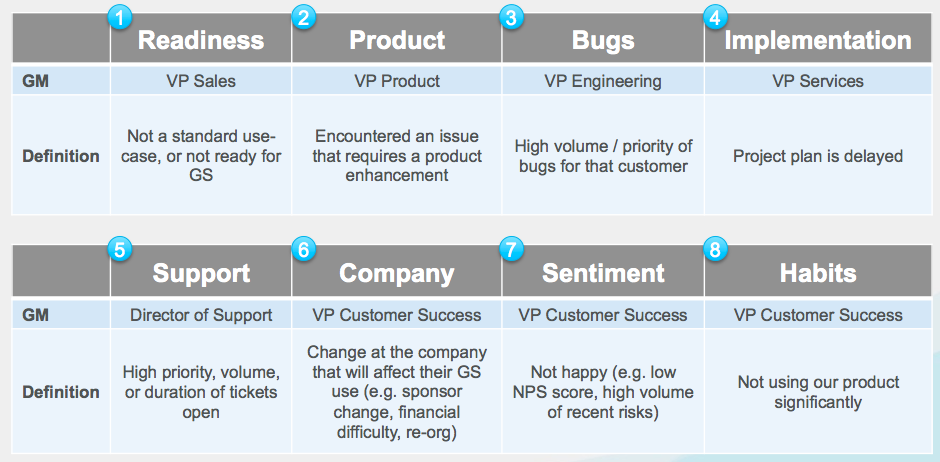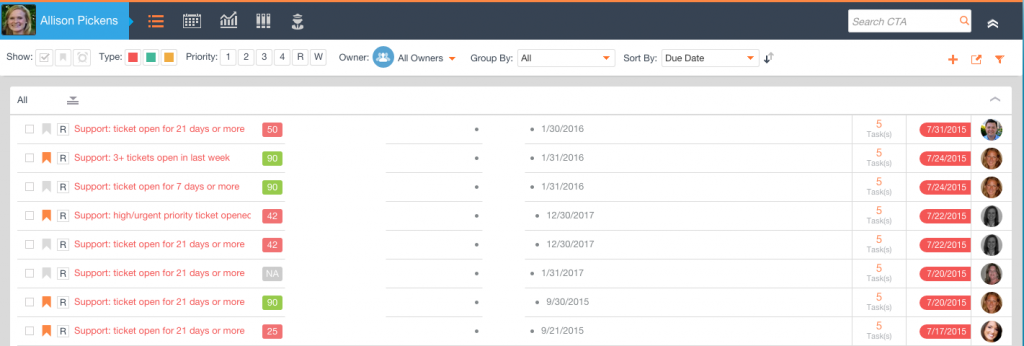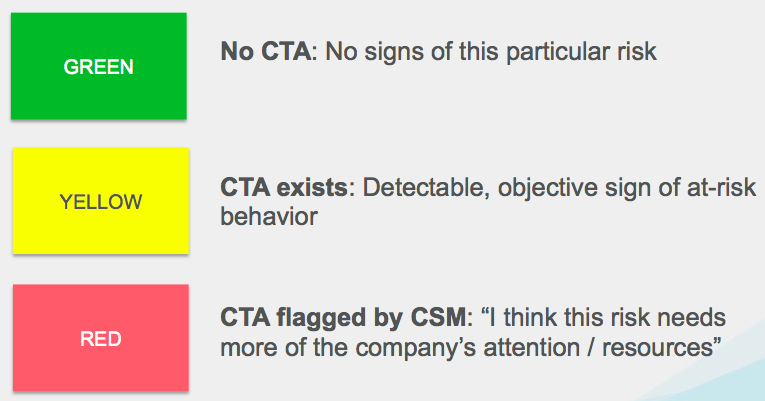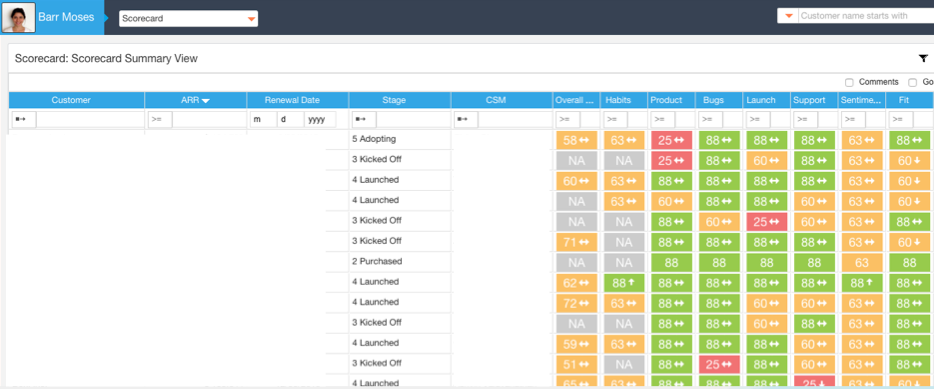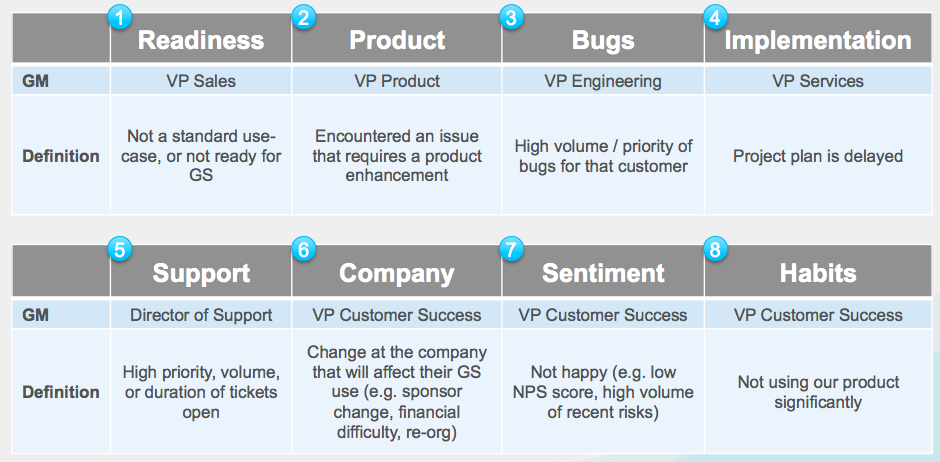Allison Pickens is VP of Customer Success & Business Operations at Gainsight
Note to Gainsight Customers: This post contains links to Vault Assets you can import directly into Gainsight.
We’re excited to unveil the latest innovation from our Customer Success incubator at Gainsight: a new framework for addressing risk, using a combination of Scorecards and Calls to Action. If you missed my talk at PulseCheck, or if you want to hear the more detailed version, you can read this post to get up to speed.
We had 4 objectives in mind when designing our Risk Management framework:
- Address early warning signs
- Incorporate the CSM’s judgment into the assessment of the risk level
- Establish a common view of risks across levels of the organization
- Hold other departments accountable for addressing risks
- Address early warning signs
What are the key signals that a customer is at risk? We’ve identified 8 categories:
We created CTAs for each of these risk areas, to help the CSM know when s/he should get involved. In most cases, the CTAs are automated according to the definitions above. In others, the CTAs are created manually by the CSM.
Note that some of these risk areas are “owned” by Customer Success; others are owned by other departments. I’ll come back to that distinction later in this post.
- Incorporate the CSM’s judgment in assessment of the risk level
Even after we invested a lot of thought into which CTAs to build, sometimes the CSM wouldn’t find a particular CTA to be super important. Maybe the CSM could handle the issue without escalating it, or s/he felt that no action was needed.
We decided that in those cases, the CSM should do one of two things:
- Resolve the issue independently and then close out the CTA, or
- Mark the CTA as “Closed – No Action,” indicating that the CTA wasn’t relevant enough to take action.
Our Customer Success Operations lead then tracks the trend of CTAs marked “Closed – No Action,” to figure out whether to adjust CTA thresholds to make them more relevant.
At other times, a CTA would be highly relevant and important, so that the CSM would want to highlight the issue to his/her manager or another department. In those situations, the CSM “flags” the CTA, by clicking on the Flag icon on the left-hand side of the CTA so that it turns orange. You can see the difference between flagged and non-flagged CTAs here:
A Flagged CTA tells me and the CSM’s direct manager that this is an issue that warrants more time and resources. Flagging also influences our Scorecards, as I’ll explain below.
- Establish a common view of risks across levels of the organization
Once we decided on our key risk categories and the CSMs began to follow up on those risks, I needed a bird’s eye view of risk in our customer base.
- What are the most important outstanding risks this week?
- Which risks does each of our top accounts have?
- Which risk category has the largest volume of issues?
I also needed a way to:
- Communicate these risks to our CEO and the rest of our leadership team
- Make sure that our CSMs and team managers agreed with the list of accounts that I highlighted as at-risk
With these goals in mind, we created a Scorecard component for each of the 8 risk categories. We then linked those Scorecards to Risk CTAs – that is, the existence of a particular Risk CTA influences the color of the corresponding Scorecard. Here’s the structure of each Scorecard:
To illustrate the value of this framework, let’s take Support Risk as an example. Our Support Risk CTA triggers when there is one of 3 situations:
- High volume of support tickets
- A ticket has been open for a long period of time
- The priority level is High or Urgent
The color of our associated Support Risk Scorecard changes automatically in response to these CTAs:
- Green: This is the default color. If there’s no Support Risk CTA, then the Support Risk Scorecard is green.
- Yellow: A Support Risk CTA exists.
- Red: The CSM has “flagged” the Support Risk CTA, indicating a belief that the issue requires greater attention.
There are enormous advantages to this methodology:
- Whenever I see that a scorecard is red, I can feel reassured that someone is working on the underlying issue.
- Conversely, whenever a CSM is taking action, I am aware of it and can help out as needed.
We now have a single source of truth for which customers are at risk.
To make this visual, the Scorecards that we review at our weekly leadership team meeting…
… reflect the same Flagged CTAs that are in Cockpit:
Now, let’s move on to the 4th objective of the risk framework.
- Your CEO is holding you accountable for a situation that isn’t in your hands
A few weeks ago, I wrote about the RACI framework that we implemented to ensure that each department was accountable for surmounting customer challenges that fell under their domain. We’ve embedded that RACI framework into our process for using Gainsight.
You might have noticed in the image of the 8 scorecard categories (copied again below) that a member of our executive team owns each category. For example, our VP of Sales makes sure that our account executives are selling to customers that are ready for Gainsight; our VP of Engineering oversees his team’s efforts to resolve any bugs that may arise.
You’ll see that Customer Success independently owns only 3 of these categories:
- Company Risk: We can’t fully control what happens at our customers (e.g. a re-org), but we can take actions that mitigate the resultant risk to adoption and the renewal. For example, we can build relationships with any new executive sponsors and recommend necessary adaptations to the company’s implementation of Gainsight.
- Sentiment Risk: We follow up on NPS ratings and track any other indications of a customer’s “emotional state,” or inclination to renew.
- Habits Risk: Naturally, we want the customer to adopt the product in a way that (a) helps them derive maximal value and (b) is sticky. A CTA triggers when the customer isn’t using the product as we would hope.
At our weekly leadership team meeting, each executive discusses the risks in their category and the next steps.
*** Note that our Risk Management process may not be suitable for companies that are Tech Touch only, since they will not be using CTAs. In addition, this process may not be optimal for CSM teams that are very high-touch (e.g. with 5 accounts per CSM) and therefore don’t substantially benefit from using CTAs. But, if you have a classic team with CSMs who are managing a moderate number of accounts, this Risk Management process can be impactful
If you have questions about how to implement your own Risk Management process, feel free to reach out to your CSM or to Allison at apickens@gainsight.com. We’ll also be publishing more content about this topic in the future.
You can follow Allison’s blog posts on Twitter at @PickensAllison.
Vault Assets mentioned in this post
(for Gainsight customers only)
Here are ready-to-use versions of what you’ve seen in this post:
- Set Score 1: Set Greens for all Measures
- Readiness Risk: Set Score 2: Set Yellows & Reds based on CTAs
- Company Risk: Set Score 2: Set Yellows & Reds based on CTAs
- Sentiment Risk: Set Score 2: Set Yellows & Reds based on CTAs
- Product Risk: Set Score 2: Set Yellows & Reds based on CTAs
- Implementation Risk: Set Score 2: Set Yellows & Reds based on CTAs
- Bugs Risk: Set Score 2: Set Yellows & Reds based on CTAs
- Support Risk: Set Score 2: Set Yellows based on CTAs
- Support Risk: Set Score 3: Set Reds based on Flagged CTAs
